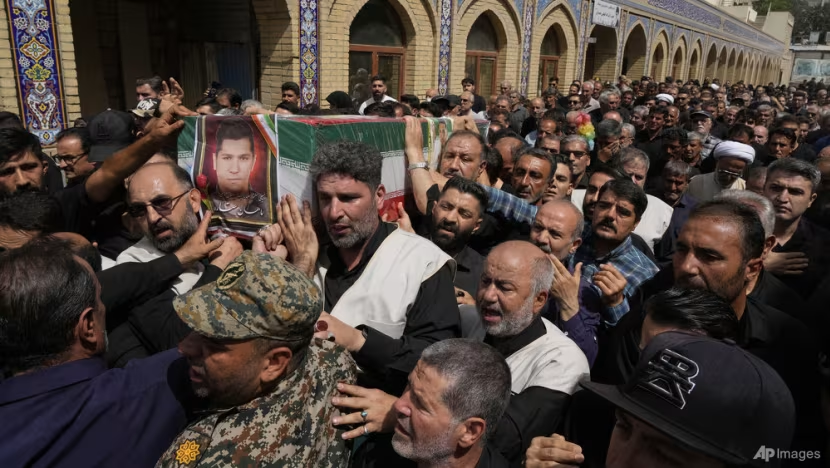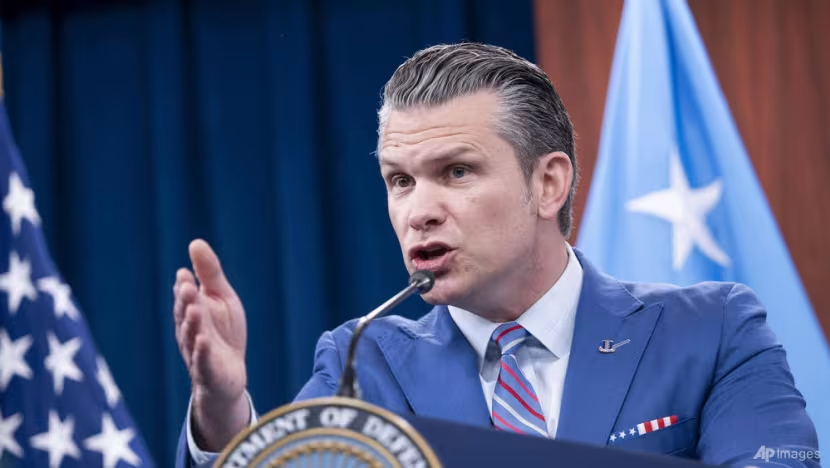US defence secretary Pete Hegseth did not definitively state that the enriched uranium and enriching centrifuges at the heart of Iran’s controversial nuclear programme had been wiped out.
WASHINGTON: US defence secretary Pete Hegseth insisted on Thursday (Jun 26) that American strikes on Iranian nuclear sites were a success, backing President Donald Trump and berating the media for questioning the results of the operation.
American B-2 bombers hit two Iranian nuclear sites with massive GBU-57 bunker-buster bombs last weekend, while a guided missile submarine struck a third site with Tomahawk cruise missiles.
“President Trump created the conditions to end the war, decimating – choose your word – obliterating, destroying Iran’s nuclear capabilities,” Hegseth told journalists at the Pentagon, referring to a 12-day conflict between Israel and Iran.
Trump has called the strikes a “spectacular military success” and repeatedly said they “obliterated” the nuclear sites.
NO INTELLIGENCE ON URANIUM MOVEMENT
On Thursday, he insisted that Iran did not manage to move nuclear materials, including enriched uranium – ahead of the US military action.
“Nothing was taken out of facility. Would take too long, too dangerous, and very heavy and hard to move!” Trump said in a post on his Truth Social platform.
This was echoed by Hegseth. “I’m not aware of any intelligence that I’ve reviewed that says things were not where they were supposed to be, moved or otherwise,” he said. He reiterated this point in a fiery news conference, saying the reports of uranium being moved lacked supporting intelligence.
However, several experts cautioned this week that Iran likely moved a stockpile of near weapons-grade highly enriched uranium out of the deeply buried Fordow site before the strikes, and could be hiding it and other nuclear components in locations unknown to Israel, the US, and UN nuclear inspectors.
They noted satellite imagery from Maxar Technologies showing “unusual activity” at Fordow on Thursday and Friday, with a long line of vehicles waiting outside an entrance to the facility.
A senior Iranian source told Reuters on Sunday that most of the 60 per cent highly enriched uranium had been moved to an undisclosed location before the US attack. The Financial Times, citing European capitals, reported that Iran’s highly enriched uranium stockpile remains largely intact since it was not concentrated at Fordow.

MEDIA “HATRED” AND ASSESSMENT DISPUTES
US media revealed a preliminary American intelligence assessment earlier this week that said the strikes only set back Iran’s nuclear programme by months, coverage sharply criticised by Hegseth.
“Whether it’s fake news CNN, MSNBC or the New York Times, there’s been fawning coverage of a preliminary assessment.”
The document was “leaked because someone had an agenda to try to muddy the waters and make it look like this historic strike wasn’t successful”, Hegseth said.
He said the leaked assessment was a low-confidence report, and cited CIA Director John Ratcliffe as saying it had already been overtaken by more recent intelligence showing Iran’s nuclear programme was severely damaged and would take years to rebuild.
Trump has also lashed out at coverage of the intelligence report, calling for journalists to lose their jobs.
Hegseth described the strikes as “historically successful”. His comments came after Iranian Supreme Leader Ayatollah Ali Khamenei said on Thursday that Iran would respond to any future US attack by striking American military bases in the Middle East. Khamenei, 86, claimed victory after 12 days of war and promised Iran would not surrender despite Trump’s calls.
Hegseth did not definitively state that the enriched uranium and enriching centrifuges at the heart of Iran’s controversial nuclear programme had been wiped out, but cited intelligence officials, although giving little detail, as saying the nuclear facilities were destroyed.
“If you want to know what’s going on at Fordow, you better go there and get a big shovel, because no one’s under there right now,” Hegseth said, referring to the deep-underground nuclear site.
MILITARY TECHNICAL BRIEFING
During the press conference, the top US general largely stuck to technical details, outlining the history of the bunker-busting bombs used. General Dan Caine, the chairman of the Joint Chiefs of Staff, showed a video testing the bombs on a bunker like the ones struck on Sunday.
Caine declined to provide his own assessment of the strike and deferred to the intelligence community. He denied being under any pressure to change his assessment to present a more optimistic view of the US strikes.
He also said he would not change his assessment due to politics. Uniformed military officials are supposed to remain apolitical and provide their best military advice.
“I’ve never been pressured by the president or the secretary to do anything other than tell them exactly what I’m thinking, and that’s exactly what I’ve done,” he said.
REGIONAL AND DIPLOMATIC CONTEXT
Israel launched an unprecedented air campaign targeting Iranian nuclear sites, scientists and top military brass on Jun 13 in a bid to end the nuclear programme, which Tehran says has only civilian purposes but Washington and other powers say is pursuing atomic weapons.
Trump had spent weeks pursuing a diplomatic path to replace the nuclear deal with Tehran that he tore up during his first term in 2018, but he ultimately decided to take military action.
The US operation was massive, involving more than 125 US aircraft, including stealth bombers, fighters and aerial refueling tankers as well as a guided missile submarine.
Source: Agencies/fh

